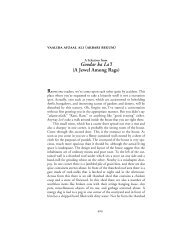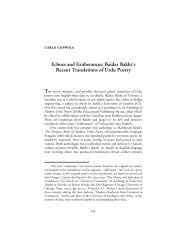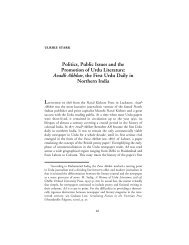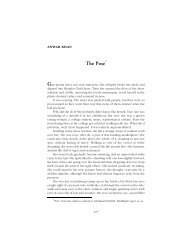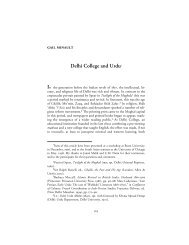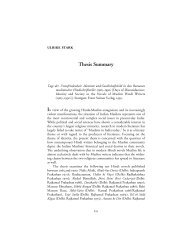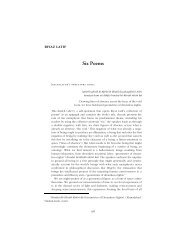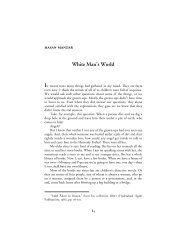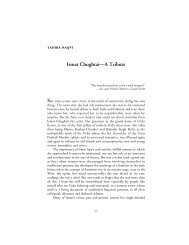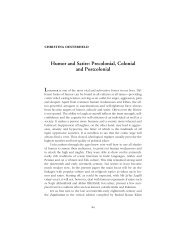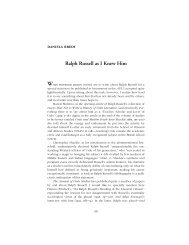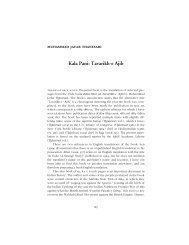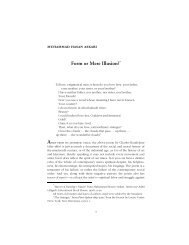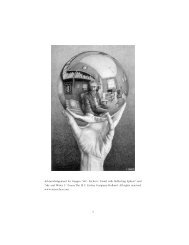Premchand's âShatranj ke Khilariâ in Translation - the Annual of Urdu ...
Premchand's âShatranj ke Khilariâ in Translation - the Annual of Urdu ...
Premchand's âShatranj ke Khilariâ in Translation - the Annual of Urdu ...
Create successful ePaper yourself
Turn your PDF publications into a flip-book with our unique Google optimized e-Paper software.
Fatima Rizvi • 201<br />
well have been <strong>the</strong> reason for Premchandís cont<strong>in</strong>ued self-translations/<br />
transcreations despite his pr<strong>of</strong>essed preference for <strong>the</strong> new national language.<br />
Several o<strong>the</strong>r reasons may be ascribed to <strong>the</strong>se exercises which created<br />
a large corpus <strong>of</strong> bil<strong>in</strong>gual oeuvre. Perhaps, <strong>in</strong>itially, he took to writ<strong>in</strong>g <strong>in</strong><br />
H<strong>in</strong>di to avoid <strong>the</strong> proscriptive eye <strong>of</strong> <strong>the</strong> government. His cont<strong>in</strong>u<strong>in</strong>g to<br />
do so may also be ascribed to his be<strong>in</strong>g <strong>in</strong> governmental service. The new<br />
<strong>of</strong>ficial language be<strong>in</strong>g H<strong>in</strong>di, he envisioned <strong>the</strong> need to develop a body<br />
<strong>of</strong> literature <strong>in</strong> this modern language. It is also li<strong>ke</strong>ly that <strong>the</strong> unadorned,<br />
simple and direct style <strong>of</strong> modern H<strong>in</strong>di prose, still <strong>in</strong> its evolutionary stage,<br />
as opposed to <strong>the</strong> ornate and verbose style <strong>of</strong> <strong>Urdu</strong>, was better suited to<br />
deliver<strong>in</strong>g <strong>the</strong> message <strong>of</strong> psychological, social and political realism on<br />
which his stories were centered. Premchand believed that <strong>in</strong> <strong>the</strong> current<br />
politically and socially turbulent times, literature ought to embody a moral<br />
purpose and express true emotions and realities (ibid., 278). Hence realism<br />
ought to precede craftsmanship. As is evident from <strong>the</strong> Presidential address<br />
he delivered at <strong>the</strong> <strong>in</strong>augural session <strong>of</strong> <strong>the</strong> All India Progressive Writersí<br />
Association <strong>in</strong> April 1936 <strong>in</strong> Lucknow, he also believed that literature should<br />
describe ìsome truth, <strong>in</strong> a mature, ref<strong>in</strong>ed, and graceful language,î which<br />
affected <strong>the</strong> m<strong>in</strong>d and <strong>the</strong> heart; that it was best def<strong>in</strong>ed as a ìcriticism <strong>of</strong><br />
lifeî (qtd. <strong>in</strong> Rahbar 1957, 166–67).<br />
“Shatranj <strong>ke</strong> Khilari” and “Shatranj ki Bazi”<br />
ìShatranj kē Khilāṛīî belongs to <strong>the</strong> genre <strong>of</strong> <strong>the</strong> serious, <strong>in</strong>ward-look<strong>in</strong>g<br />
short story which propagates utilitarian and political ideals. It is to <strong>the</strong> political<br />
culture <strong>of</strong> <strong>the</strong> times that this text, perhaps, owes its existence. Written<br />
dur<strong>in</strong>g Premchandís stay <strong>in</strong> Lucknowóa phase described as both comfortable<br />
and prolific (Rai 2002, 205)ó<strong>the</strong> story center-stages Lucknow as<br />
<strong>the</strong> seat <strong>of</strong> monarchial <strong>in</strong>dolence and cultural pr<strong>of</strong>ligacy characteristic <strong>of</strong> <strong>the</strong><br />
k<strong>in</strong>gdom <strong>of</strong> <strong>the</strong> erstwhile Awadh. Rai th<strong>in</strong>ks this story was meant to serve<br />
as a wa<strong>ke</strong> up call for <strong>the</strong> populace <strong>in</strong> regard to <strong>the</strong> politically <strong>in</strong>dolent situation<br />
<strong>of</strong> Indiaís on-go<strong>in</strong>g freedom struggle, to sha<strong>ke</strong> it out <strong>of</strong> its complacency<br />
(ibid., 209–10). Thus, Premchand believes <strong>in</strong> <strong>the</strong> circular notion <strong>of</strong><br />
history; he uses <strong>the</strong> historic past to comment on <strong>the</strong> political present. The<br />
story is s<strong>ke</strong>letal <strong>in</strong> that it revolves around <strong>the</strong> obsession with play<strong>in</strong>g<br />
chess, aga<strong>in</strong>st all odds, <strong>of</strong> <strong>the</strong> jāgīrdārs (landowners) Mīr Raushan ʿAlī and<br />
Mirzā Sajjād ʿAlī, who represent <strong>the</strong> élitist, Muslim cultural center. These<br />
two chess-players are real-life motifs illustrat<strong>in</strong>g a more serious <strong>the</strong>me than<br />
at first meets <strong>the</strong> eye. Premchand also conveys his serious political mes-



